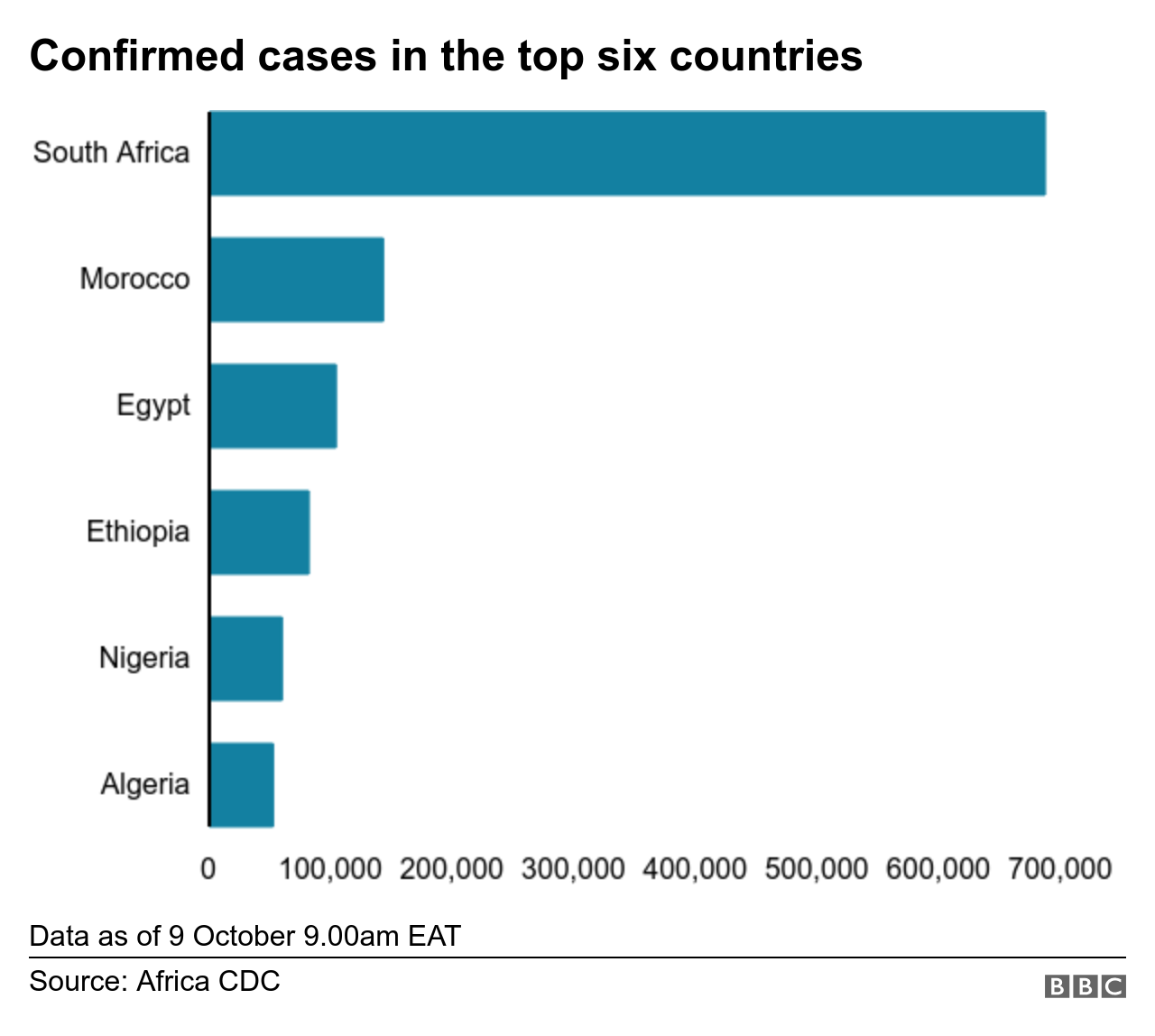The World Health Organization (WHO) has said the Covid-19 outbreak in Africa may have passed its peak, but warns governments not to be complacent as countries relax their restrictions.
The number of new daily confirmed cases overall has been dropping since mid-July, although some countries are still seeing a rise in cases.
At what rate is coronavirus spreading?
Over the past four weeks, there has been an average 1.7% increase in the number of weekly new cases being reported, according to the Africa Centres for Disease Control (CDC).
This is largely due to an increase in new cases in countries in North Africa which registered a 6% increase in new cases over the past four weeks.
The rise in new cases in the region has largely been driven by an increase in cases in Morocco, Tunisia and Libya.
These countries are among the top five on the continent by overall cases per capita.
Morocco has been experiencing a sustained increase in new cases and has had the highest number of new cases on the continent over the past four weeks.
Tunisia and Libya were among the five countries with the highest number of new cases over the past two weeks.
There are also some countries elsewhere on the continent experiencing an increase in new cases.
These include Ethiopia, Seychelles, Equatorial Guinea, Eritrea, Guinea-Bissau, Benin, Togo, Liberia, Democratic Republic of the Congo, Zambia, Senegal and Mali.
The Africa CDC warns that Africa is not out of the woods yet.
“I don’t think we are over the first wave yet, we have not yet hit the bottom at all,” says the CDC’s John Nkengasong.

The global humanitarian relief body, the International Rescue Committee, says it believes the true scale of the pandemic may be hidden because of a lack of testing and issues with data.
And the WHO says changes in testing capacity and strategy can also affect numbers.
Which countries have been most affected?
South Africa has the highest recorded number of total cases and reported deaths in Africa, and the tenth highest number of cases in the world.
Daily reported numbers and hospital admissions have been falling for close on two months.
Health minister Zwelini Mkhize says they have confirmed the country is now officially past the surge.
There is however still some concern that the country could be missing some cases.
South Africa’s National Institute for Communicable Diseases says changes in testing could have contributed to the drop in the number of confirmed cases.
There is also concern about spread of the virus in rural areas.
WHO says although new cases have been on a steady decline in highly populated provinces of Gauteng and the Western Cape, weekly case numbers have been rising in less populated provinces.
And research from the South African Medical Research Council (SAMRC) indicates the number of people who have died from the virus could be much higher than reported.
It says excess deaths, which is the difference between deaths over a particular period and the historical average, rose by 17,000 – that’s a 59% increase compared with previous years.
Morocco has overtaken Egypt and has the second highest number of cases, although Egypt is still the second in terms of deaths recorded so far.
Egypt has the third highest number of cases, followed by Ethiopia and Nigeria.
The reported death rate per capita has been low compared with other parts of the world, despite the poor health infrastructure in many African countries.
The WHO says this could be partly because of the relatively young population in Africa – more than 60% under the age of 25.
Covid-19 is known to have a higher mortality rate for older age groups, and among people health problems like obesity and type 2 diabetes which are also less common in Africa.
Experts also say expertise in epidemic control from tackling other outbreaks, cross-immunity from other coronaviruses, low travel and outdoor living could also be contributing to Africa coping better.
In terms of what proportion of people who get Covid-19 go on to die, there were 12 African countries with rates comparable with or higher than the global average rate of 2.9% on 8 October.
How much testing is done in Africa?
Ten countries account for close to 80% of the total tests conducted – South Africa, Morocco, Ethiopia, Egypt, Ghana, Kenya, Nigeria, Rwanda, Uganda and Mauritius.
There are wide variations in testing rates, with South Africa doing the most and Nigeria doing relatively few per capita, according to Our World in Data, a UK-based project which collates Covid-19 information.
By 4 October, South Africa had done 72 tests per 1,000 people, but that compares with 320 in the UK and 365 in the US.
Nigeria had carried out just 2.6 tests per 1,000 people by then, while Kenya had done 10.5 tests.
About half of the countries on the continent have a ratio lower than the benchmark of doing at least 10 tests for every positive case recommended by the Africa CDC.
And in some countries, there’s insufficient data available on testing.
Source: BBC



